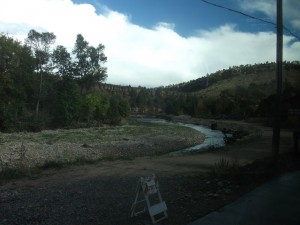How do states plan for resilience? On Thursday, September 22, the Association of State Floodplain Managers (ASFPM) will host a webinar on state resilience plans through the Planning Information Exchange (PIE). This is the last in a two-year series led by the American Planning Association (APA), with which ASFPM has partnered, which is likely to be extended for two more years. The webinar is free as part of a
FEMA-sponsored project by the two organizations. I highly recommend registering for and listening to it if you have an hour for the purpose and are interested in resilience, a subject I have discussed before on this blog. Like other PIE webinars, it will also be recorded and archived on the APA website.
The subject of resilience has gained credence in recent years because it deals with the ways in which communities can prepare to rebound more quickly and efficiently from setbacks including natural disasters. The federal response to Hurricane Sandy highlighted the issue, but so have several other disasters in recent years. The U.S. Department of Housing and Urban Development subsequently offered nearly $ billion in the National Disaster Resilience Competition for states and certain disaster-stricken eligible communities. Winners have been chosen and are already using the money for their proposed projects.
The operative question is what characteristics a community can cultivate that will help it better respond to such crises. But it is not just about communities. Some states in recent years have decided to take the lead in fostering resilient communities and in providing expertise to assist the process. The webinar will feature speakers from Colorado and New York.
Colorado got resilience religion, in a manner of speaking, after the September 2013 floods that affected numerous Front Range communities following a mountain monsoon rainstorm that dumped more than a foot of rain on many places. I have previously, for instance, discussed the recovery of the small town of Lyons, just below the mountains, which suffered devastating flooding. Lyons was not alone, however; it was simply one of the most extreme examples of the flooding that occurred.
Emboldened in its approach to hazard mitigation, the Colorado Department of Local Affairs (DOLA) in early 2015 issued a request for proposals to find a consulting firm to develop statewide guidance customized to Colorado communities on the integration of hazard mitigation into community planning processes. Colorado deals with an interesting assortment of major hazard threats—floods, landslides, tornadoes, wildfires, and avalanches, to name the most significant. Often, these combine in a cascading series of disasters in which one problem leads to another. Things can get complicated. DOLA later published that guidance online on the agency’s website. Much of the guidance is ultimately derived from an APA Planning Advisory Service Report, Hazard Mitigation: Integrating Best Practices into Planning. Although that report did not emphasize the concept of resilience, it did lay out a rationale and method for such integration that is the focus of a good deal of current guidance from the Federal Emergency Management Agency.
Subsequently, Colorado Governor John Hickenlooper adopted the new Colorado Resiliency Framework. At the same time, he created the Colorado Resiliency and Recovery Office, which provides guidance on community resilience and maintains a website for that purpose.
New York has also been pursuing resilience issues at the state level, inspired by the impacts of Hurricane Sandy in 2012. Two years ago, Governor Andrew Cuomo signed into law the Community Risk and Resiliency Act, which requires the New York Department of Environmental Conservation to use science-based projections for sea level rise, consider those and storm surge in facility permitting, siting, and funding, and provide model local laws and guidance for communities in managing climate risks. The state is now also in the process of developing a New York State Flood Risk Management Standard that mirrors the federal standard promulgated by the Obama administration last year.
Parts of the nation may be gun-shy about the subject of climate change, but Colorado and New York are major parts of a bandwagon of states that have decided to confront the issue and build a more resilient future. Rhode Island in 2014 adopted the Resilient Rhode Island Act, which establishes a scientific advisory board to examine and recommend standards for the state. The new law has strong civic support and a cheering section in Resilient Rhode Island, a group supporting the new legislation.
There will be other states following the lead of these three. With Colorado on board, it is also clear that resilience is not an issue solely facing coastal states because of sea level rise. Disaster threats to communities take many forms, and climate change has consequences for inland areas as well. Wiser state legislatures will be taking a long look at how to get ahead of the problem instead of merely reacting to it.
P.S.: For those interested in learning more about disaster recovery, especially if you are in a position to act on the information, I can also suggest a Friday, September 23, two-hour Recovery Planning Webinar sponsored by APA’s Hazard Mitigation and Disaster Recovery Planning Division, for which I will be one of the presenters. The division is organizing this special webinar to benefit planners and community officials in disaster-stricken areas such as Louisiana who may need to know more about how to rebuild resilient communities. If interested, please note the following:
REGISTRATION This webinar is also open to non-members of APA but first a Non-Member APA Account must be obtained (no cost) at: https://www.planning.org/myapa/account/create/ All users must pre-register at: https://www.planning.org/events/eventsingle/9111457/ Registrants will receive an email containing a user-specific login for the Adobe Connect webinar.
This FREE webinar will take place on Friday, September 23, 2016 from 11:00-1:00 p.m. EDT (10 am CDT; 9 am MDT; 8 am PDT).
Jim Schwab

